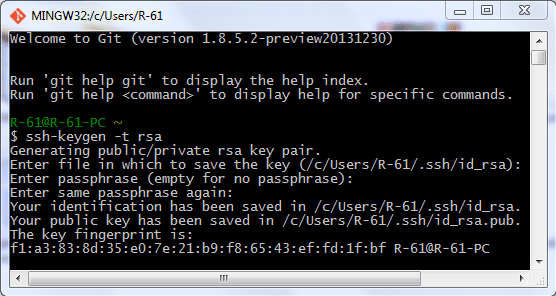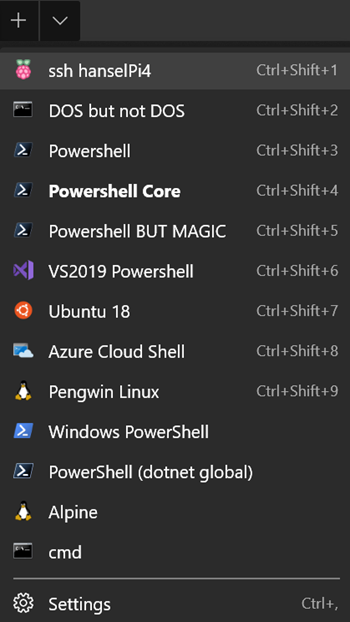- Git Command To Add Ssh Key
- Generate Ssh Key Aix
- Generate Ssh Key Git Terminal 2
- Git Command Line Add Ssh Key
SSH keys are a way to identify trusted computers, without involving passwords. The steps below will walk you through generating an SSH key and adding the public key to the server.
SSH keys are a way to identify trusted computers, without involving passwords. The steps below will walk you through generating an SSH key and adding the public key to the server. Step 1: Check for SSH Keys First, check for existing SSH keys on your computer. Open Git Bash, Cygwin, or Terminal, etc. If you are using another terminal prompt, such as Git for Windows, you can use the 'Auto-launching the ssh-agent' instructions in 'Working with SSH key passphrases', or start it manually: # start the ssh-agent in the background $ eval $(ssh-agent -s) Agent pid 59566; Add your SSH private key to the ssh-agent. The.pub file is your public key, and the other file is the corresponding private key. If you don’t have these files (or you don’t even have a.ssh directory), you can create them by running a program called ssh-keygen, which is provided with the SSH package on Linux/macOS systems and comes with Git for Windows. Generating Your SSH Public Key That being said, many Git servers authenticate using SSH public keys. In order to provide a public key, each user in your system must generate one if they don’t already have one. SSH keys can serve as a means of identifying yourself to an SSH server using public-key cryptography and challenge-response authentication.The major advantage of key-based authentication is that in contrast to password authentication it is not prone to brute-force attacks and you do not expose valid credentials, if the server has been compromised. Ensure that you generated your SSH key pair correctly and added the public SSH key to your GitLab profile; Try manually registering your private SSH key using ssh-agent as documented earlier in this document; Try to debug the connection by running ssh -Tv git@example.com (replacing example.com with your GitLab domain). Generating an SSH key. To generate an SSH key with PuTTYgen, follow these steps: Open the PuTTYgen program. For Type of key to generate, select SSH-2 RSA. Click the Generate button. Move your mouse in the area below the progress bar. When the progress bar is full, PuTTYgen generates your key pair. Type a passphrase in the Key passphrase field.
Step 1: Check for SSH Keys
First, check for existing SSH keys on your computer. Open Git Bash, Cygwin, or Terminal, etc. and enter:
Git Command To Add Ssh Key
Check the directory listing to see if you already have a public SSH key. By default, the filenames of the public keys are one of the following:
- id_dsa.pub
- is_ecdsa.pub
- id_ed25519.pub
- id_rsa.pub
If you see an existing public and private key pair listed (for example id_rsa.pub and id_rsa) that you’d like to use, you can skip Step 2 and go straight to Step 3.
Generate Ssh Key Aix
Step 2: Generate a new SSH key
With your command line tool still open, enter the text shown below. Make sure you substitute in your email address:

You’ll be asked to enter a passphrase, or simply press Enter to not enter a passphrase: /generate-256-bit-key-c.html. /openssl-generate-key-no-passphrase.html.
After you enter a passphrase (or just press Enter twice), review the fingerprint, or ‘id’ of your SSH key:
Step 3: Add your key to the ssh-agent
Generate Ssh Key Git Terminal 2
To configure the ssh-agent program to use your SSH key, first ensure ssh-agent is enabled.
If you are using Git Bash, turn on the ssh-agent with command shown below instead:
Then, add your SSH key to the ssh-agent:
Step 4: Add your SSH key to the server

To add your public SSH key to the server, you’ll copy the public SSH key you just created to the server. Substitute “username” with your username on the server, and “server.address.com” with the domain address or IP address of your server:
The server will then prompt you for your password:
Git Command Line Add Ssh Key
That’s it! You should now be set up to connect to the server without having to authenticate.
Most Viewed News
- ✔ 16 License Key Generator With Registration Id
- ✔ Key Generator For Counter Strike Condition Zero
- ✔ Microsoft Office Excel 2010 Product Key Generator
- ✔ Norton Internet Security Product Key Generator Free Download
- ✔ Solarwinds Software License Key Generator
- ✔ Business Model Generation Key Resources
- ✔ Key Generator Free Download Corel Draw X5
- ✔ Dungeon Siege Key Generator Legends Of
- ✔ Hide My Ip 6 Key Generator
- ✔ Amazon Kindle Fire 5th Generation Enter Key